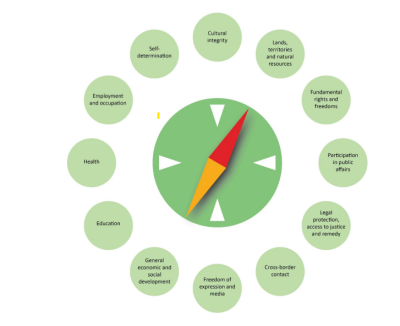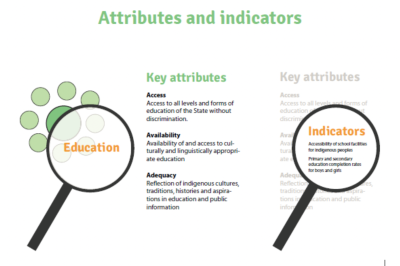Methodology (domains, links, and instruments matrix)
Methodology by which we have designed and implemented the domains, links, and instruments matrix.
The Indigenous Navigator offers a comprehensive and coherent framework to monitor the realisation of indigenous peoples' rights. It has been designed in accordance with the methodology suggested by the Office of the High Commissioner for Human Rights (OHCHR) for human rights indicators.
A transparent methodology is critical to assess the credibility and validity of the data generated. The following section therefore explains how the Indigenous Navigator tools were developed to give users an insight into the choices made in the design process, and the opportunities and limitations this entails.
The Indigenous Navigator framework was developed based on the handbook “Human Rights Indicators, A Guide to Measurement and Implementation ”, published by the OHCHR in 2012. This methodology was adapted to the rights of indigenous peoples in the following sequence:
- Structuring the rights contained in the UN Declaration on the Rights of Indigenous Peoples (UNDRIP) into thirteen thematic domains;
- Further dividing the domains into 32 sub-categories and identifying the relevant articles of the UNDRIP and related human rights instruments;
- Defining 66 key attributes of the rights enshrined in the UNDRIP; and
- Choosing the right indicators to measure the status of their attainment.
1. Structuring UNDRIP in thematic domains
As a first step towards developing the Indigenous Navigator framework, it was necessary to structure the numerous provisions of the UNDRIP according to thematic categories.
The following thematic domains were decided after a series of consultations, corresponding with the priorities and concepts put forward by indigenous partners:

FIG.1: THEMATIC DOMAINS OF UNDRIP
2. Categorising the individual articles of UNDRIP
Once the rights enshrined in the UNDRIP were structured into thematic domains, the next step was to identify the sub-categories – or building blocks – which make up these broader thematic domains. This more detailed categorisation of the rights enshrined in the UNDRIP yielded the following structure:
FIG.2: THEMATIC DOMAINS AND SUB-CATEGORIES OF UNDRIP
| DOMAINS | SUB-CATEGORIES |
| General enjoyment of human rights and fundamental freedoms without discrimination | General enjoyment of human rights and fundamental freedoms; Non-discrimination; Gender equality.
These principles of non-discrimination are mainstreamed across the framework. |
| Self-determination | Self-determination; Self-government and autonomous institutions; Identity and membership; Customary law; Consultation and free, prior and informed consent. |
| Cultural Integrity | Cultural integrity; Languages; Cultural heritage, traditional knowledge and intellectual property. |
| Lands, territories and resources | Recognition, protection and adjudication of inherent rights to lands, territories and natural resources; Dispossession, removal and relocation; Compensation, restitution and redress; Environment; Military activities. |
| Fundamental rights and freedoms | Fundamental rights and freedoms |
| Participation in public life | Citizenship; Participation in public affairs. |
Legal protection, access to justice and remedy
| Access to justice and remedy. |
Cross-border contacts
| Cross-border contact. |
Freedom of expression and media
| Freedom of expression and media; Combating prejudice and discriminatory propaganda. |
General economic and social development
| The right to food; The right to development; Social protection; Housing, water and sanitation. |
Education
| Education. |
Health
| Health. |
| Employment and occupation | The right to work and equality in employment and occupations; Child labour; Vocational training. |
Once the sub-categories were identified, the individual articles of the UNDRIP could be classified and linked to these sub-categories.
For example, articles 9, 33(1), 33(2) and 35 of the UNDRIP are all linked to the overall thematic domain of self-determination, and to the sub-category of identity and membership.
FIG. 3: INDIVIDUAL ARTICLES RELATING TO THE RIGHT TO IDENTITY AND MEMBERSHIP
| UNDRIP | |
| Identity and membership | Art. 9: Indigenous peoples and individuals have the right to belong to an indigenous community or nation, in accordance with the traditions and customs of the community or nation concerned. No discrimination of any kind may arise from the exercise of such a right. |
| Art. 33(1): Indigenous peoples have the right to determine their own identity or membership in accordance with their customs and traditions. | |
| Art. 33(2): Indigenous peoples have the right (…) to select the membership of their institutions in accordance with their own procedures. | |
| Art. 35: Indigenous peoples have the right to determine the responsibilities of individuals to their communities. |
This categorisation was done for all substantial articles of the UNDRIP, with those relating to overarching and cross-cutting principles taken into account in a cross-cutting manner. These overarching and cross-cutting principles are:
- Human rights and fundamental freedoms;
- Cross-cutting principles of human rights and non-discrimination; and
- Requirement for measures/special measures.
FIG. 4: UNDRIP GENERAL PROVISIONS REGARDING HUMAN RIGHTS AND FUNDAMENTAL FREEDOMS
| UNDRIP | |
| Human rights and fundamental freedoms | Art. 1: Indigenous peoples have the right to the full enjoyment, as a collective or as individuals, of all human rights and fundamental freedoms as recognized in the Charter of the United Nations, the Universal Declaration of Human Rights, and international human rights law. |
| Art. 46(2): In the exercise of the rights enunciated in the present Declaration, human rights and fundamental freedoms of all shall be respected. The exercise of the rights set forth in this Declaration shall be subject only to such limitations as are determined by law and in accordance with international human rights obligations. Any such limitations shall be non-discriminatory and strictly necessary solely for the purpose of securing due recognition and respect for the rights and freedoms of others and for meeting the just and most compelling requirements of a democratic society. | |
| Art. 46(3): The provisions set forth in this Declaration shall be interpreted in accordance with the principles of justice, democracy, respect for human rights, equality, non-discrimination, good governance and good faith. |
3. Defining key attributes of the rights enshrined in UNDRIP
The next step towards defining the best indicators to measure the rights enshrined in the UNDRIP was to identify the key attributes of these rights.
The key attributes are the main aspects or elements of which a particular right is composed.
For example, the State duty to combat prejudice and discriminatory propaganda comprise two key attributes:
- Prevent and provide redress for propaganda inciting discrimination against indigenous peoples; and
- Establish effective measures to combat prejudice and discrimination against indigenous peoples and promote tolerance, understanding and good relations.
Likewise, indigenous peoples’ right to vocational training comprise two key attributes:
- Access to general vocational training without discrimination; and
- Availability of, and access to, vocational training according to indigenous peoples’ special needs.
The definition of key attributes specifies the various aspects of the rights concerned. It therefore helps to identify the best indicators to adequately measure these aspects and ensure that all aspects are covered by the indicators.

4. Choosing the right indicators
The next step consisted of choosing the best indicators to measure the key attributes pertaining to each right of the UNDRIP.
The Indigenous Navigator indicator framework comprises a complete set of indicators for all key aspects of the UNDRIP. Where relevant, indicators for monitoring the commitments made by states at the World Conference on Indigenous Peoples in 2014 have been integrated into the framework. Those UNDRIP indicators that also serve to monitor specific WCIP commitments are highlighted in this toolkit. In the same way, relevant global SDG indicators have been integrated and highlighted.
For easy reference, the full set of indicators to monitor the UNDRIP, as well as the WCIP indicators and SDG indicators integrated into the Indigenous Navigator framework, are also available separately :
- Indicators for monitoring the UN Declaration on the Rights of Indigenous Peoples;
- Indicators for monitoring the outcome of the World Conference on Indigenous Peoples; and
- Leaving no-one Behind! Integration of global SDG indicators into the Indigenous Navigator monitoring framework.
The selection of indicators has followed the approach suggested by the OHCHR (see section 1). The indicators monitor different aspects of States’ duty to respect, protect and fulfil indigenous peoples’ human rights, and comprise structural, process and outcome indicators:
- Structural indicators reflect the legal and policy framework of a given country.
- Process indicators measure the States’ ongoing efforts to implement human rights commitments through programs, budget allocations, etc.
- Outcome indicators capture the actual enjoyment of human rights by indigenous peoples.
Some of the general considerations that guided the selection of indicators were:
- The indicators should be based on the UNDRIP, but also have direct relevance for other human rights instruments, thereby allowing the data to be directly relevant for existing human rights monitoring mechanisms.
- The intertwined elements of self-determination and non-discrimination should be monitored throughout the framework.
- To the extent possible, the indicators should be carefully conceptualized in order to serve multiple purposes – for example, guiding indigenous peoples’ own strategies while also holding governments accountable for their human rights obligations.
- To the extent possible, the indicators should be universal, i.e. they should be relevant for indigenous peoples across the globe in order to allow for comparisons across communities, peoples, countries and regions.
- To the extent possible, the framework should make use of existing indicators, such as those adopted to monitor the SDGs, which may already be measured through recurrent general data collection. By doing this, even small-scale data collection by indigenous communities can be compared to data on the general population, and thereby measure discrimination.
- The framework should include process indicators to measure States’ efforts to implement indigenous peoples’ rights, as this information will be useful for both guiding the implementation process and holding States to account
The indicators for the Navigator framework were selected through a painstaking process, including a comprehensive review of existing and proposed indicators, several rounds of consultations among the partners and resource persons, field testing and final adjustment after field testing.
The final indicators were selected from:
- Indicators suggested by indigenous peoples in previous processes;
- The global indicators adopted for monitoring the SDGs;
- Indicators already used by international agencies; and
- New indicators developed by the Indigenous Navigator partners, tailored specifically to assess compliance with the UNDRIP and with WCIP commitments by States.
BUILDING ON PREVIOUS PROCESSES BY INDIGENOUS PEOPLES TO DEFINE INDICATORS A key resource and inspiration for the definition of indicators was the comprehensive set of indicators developed by indigenous peoples themselves. Over the last decade, a series of local, national, regional and international processes have been carried out in order to define indicators for indigenous peoples’ rights and well-being. Key initiatives in this regard have been undertaken by the United Nations Permanent Forum on Indigenous Issues (UNPFII), the Fondo Indígena, the Secretariat of the Convention on Biological Diversity (SCBD), the International Indigenous Forum on Biodiversity (IIFB) and others. See: https://www.un.org/development/desa/indigenouspeoples/mandated-areas1/data-and-indicators.html http://unstats.un.org/unsd/demographic/sources/census/docs/P&R_%20Rev2.pdf |